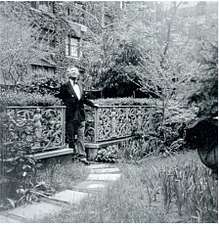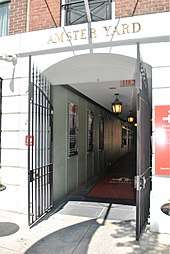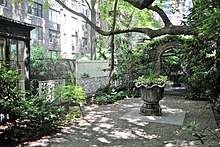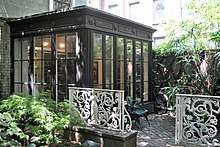James Amster
James Amster (July 18, 1908 – June 11, 1986) was an interior decorator in New York City in the 1960s who created the Amster Yard, a New York Historic Landmark.[1]

Early life
Amster was born on July 18, 1908, in Lynn, Massachusetts, and grew up in Boston, in a house with a yard, probably the reason why he decided to restore the Amster Yard in Manhattan.[1][2]
Amster attended the Museum of Fine Arts, Boston, where he studied sculpture and painting.[1]
Career

Amster was known for his community involvement on the Turtle Bay, Manhattan, neighborhood, and for his traditional style as interior decorator.[1]
At first Amster worked for Bergdorf Goodman, a luxury goods department store based on Fifth Avenue in New York City and opened and managed its decorating and antiques department.[1]
Amster went solo in 1938, opening his design firm. Among his clients: businesses, shipbuilders and hotels in both Central America and United States. He is the interior designer responsible for the redecoration of The Pierre, a luxury hotel located at 2 East 61st Street, Manhattan.[1]
In 1957 Amster founded E. 49th Street Association, later Turtle Bay Association. The first meetings of the association were held at Amster Yard.[1][3]
Amster was also affiliated with: the Prescott Neighborhood House (chairman), the Prescott Nursery School (chairman) and the Friends of Peter Detmold Park Foundation (president).[1] Peter Detmold (1923–1972)[4] was a friend of Amster from the Turtle Bay Association, who was killed in 1972; his murderer was never found.[5]
Amster Yard
In 1944 Amster restored what is now known as Amster Yard, designated in 1966 a New York City Designated Landmark, at 211 1/2 East 49th Street. The building was originally a 19th-century boarding house, a station of the Boston Post Road and a commercial yard, but when Amster bought it in 1944 it was abandoned.[6]
Amster renovated the building, with the help of Ted Sandier (architect) and Harold Sterner (artist),[7][8] creating an inner yard connecting several apartments/studios which he rented to many key figures in the design field: Norman Norell (fashion designer), Billy Baldwin(interior designer), Isamu Noguchi (sculptor),[9] and SwidPowell[10] (firm). Across the yard there was a Greek handicraft store where Jacqueline Kennedy used to shop.[1][3]

One of the apartments was Amster's home, which he decorated with Biedermeier furniture; his 1946 Christmas tree, decorated with 15th and 16th century saints, a Christ child, and 18th century hand-blown glass balls was featured on a full page on Life Magazine on December 9.[11]
During the party hosted by Amster to inaugurate the Yard, Elsie de Wolfe, mentor to Amster, suggested that he put a mirror at one end of the Yard to give the impression that the Yard was bigger. Amster framed the mirror inside an arch. The mirror is still in place at the Yard today.[3]
Personal life

James Amster was in a long-lasting relationship with Robert K. Moyer.[3] Concerning the Amster-Moyer relationship, journalist and friend Mike Wallace described them in 1995 as "a wonderful old married couple" and "both people that [sic] I admired".[12]
Amster was also friends with Constance Spry, British educator and florist, and Syrie Maugham, leading British interior decorator of the 1920s and 1930s and wife to W. Somerset Maugham.[13]
Amster died of leukemia on June 11, 1986. Moyer continued to live at Amster Yard until 1992, when he was the last tenant to move out. Amster Yard was acquired in 1999 and renovated by the Instituto Cervantes, New York, and since 2002, the Instituto allows people to use the yard as a pocket park.[1][9] However, when the Instituto acquired the property, much of it was destroyed. And, indeed, the premises had fallen into disrepair. According to Tina Kelley in The New York Times in 2002: "Most of its courtyard, trees and walkways have been dug up, right down to the schist..... Most of its buildings have been demolished."[14] Thus, even though the New York City Landmarks Preservation Commission stepped in after the damage was done, the Instituto through its site's developers, the Instituto Cervantes, promised to restore the Yard. However, a complete restoration is not as it was. Kelley in The Times's May 21, 2002, article reported: "But some people involved in the project regret that the final product will not include the actual older, protected buildings."[15]
References
- LAWSON, CAROL. "JAMES AMSTER, 77, DECORATOR, DEAD". The New York Times. Retrieved 31 July 2017.
- Pool, Mary Jane; Seebohm, Caroline (1980). 20th Century Decorating, Architecture & Gardens: 80 Years of Ideas and Pleasure from House & Garden. Holt, Rinehart and Winston. p. 211. ISBN 9780030475818. Retrieved 31 July 2017.
- Hanlon, Pamela (2008). Manhattan's Turtle Bay: Story of a Midtown Neighborhood,. Arcadia Publishing. p. vii. ISBN 9780738525235. Retrieved 31 July 2017.
- https://www.nycgovparks.org/parks/peter-detmold-park
- Johnson, Mary (February 23, 2012). "Ex of Slain Preservationist Wants His Unsolved 1972 Murder Case Reopened". DNAinfo.com. Archived from the original on 31 July 2017. Retrieved 31 July 2017.
- Diamonstein-Spielvogel, Barbaralee (2011). The Landmarks of New York, Fifth Edition: An Illustrated Record of the City's Historic Buildings. SUNY Press. p. 226. ISBN 9781438437712. Retrieved 31 July 2017.
- Dolkart, Andrew (2008). Guide to New York City Landmarks. John Wiley & Sons. p. 118. ISBN 9780470289631. Retrieved 31 July 2017.
- U.S. Mission to the United Nations, 799 United Nations Plaza, New York, NY 10017: Environmental Impact Statement. 2001. Retrieved 31 July 2017.
- White, Norval; Willensky, Elliot; Leadon, Fran (2010). AIA Guide to New York City. Oxford University Press. ISBN 9780199758647. Retrieved 31 July 2017.
- https://www.nytimes.com/1990/11/29/garden/architects-show-how-to-set-a-grand-table.html
- Inc, Time (9 December 1946). "LIFE". LIFE (Vol. 21, Num. 24): 81. Retrieved 31 July 2017.
- Kaiser, Charles (1997). The Gay Metropolis 1940–1996. New York: Houghton Mifflin. p. 171. ISBN 0-395-65781-4. Retrieved 31 July 2017.
- Shephard, Sue (2010). The Surprising Life of Constance Spry. Pan Macmillan. p. 102. ISBN 9780330536103. Retrieved 31 July 2017.
- Tina Kelley, "A New York Landmark in Rubble: Preservationists Protest Demolition at Amster Yard." https://www.nytimes.com/2002/05/21/nyregion/a-new-york-landmark-in-rubble-preservationists-protest-demolition-at-amster-yard.html
- Tina Kelley, "A New York Landmark in Rubble: Preservationists Protest Demolition at Amster Yard." https://www.nytimes.com/2002/05/21/nyregion/a-new-york-landmark-in-rubble-preservationists-protest-demolition-at-amster-yard.html